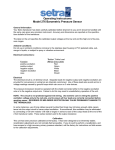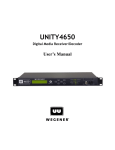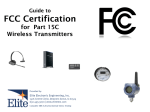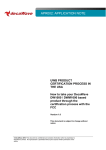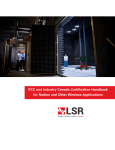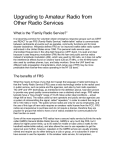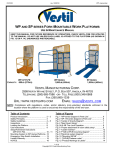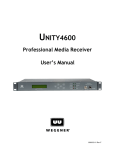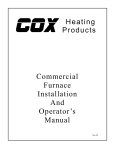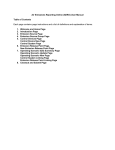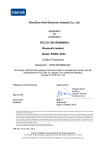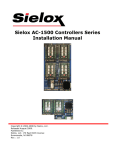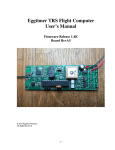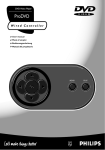Download TCB User's Guide
Transcript
TCB User's Guide TABLE OF CONTENTS page WELCOME ................................................................................................................... 2 Who can use the program? ................................................................................ 2 Certification services offered .............................................................................. 2 Can TCBs approve all devices? .......................................................................... 3 RF exposure considerations ................................................................................ 3 GETTING STARTED ................................................................................................... 4 Confidentiality...................................................................................................... 4 Certification agreement ....................................................................................... 5 TCB certification process .................................................................................... 6 TEST REQUIREMENTS & ASSESSMENT ............................................................. 7 Application submittals - RF devices ................................................................... 7 Application submittals - Part 68 telephone devices .......................................... 8 RESPONSE TO REQUESTED INFORMATION ..................................................... 9 CERTIFICATIONS .................................................................................................... 10 Prices and payment methods ............................................................................ 10 Surveillance ........................................................................................................ 10 ANNEX A - RF device certification exhibits ............................................................. 11 ANNEX B - Part 68 terminal equipment certification exhibits ............................... 13 ANNEX C - Product label formats............................................................................. 15 ANNEX D - User information for RF devices ........................................................... 16 version 2.3 (c) 2015 page 1 of 16 Intertek Testing Services NA, Inc. 70 Codman Hill Road, Boxborough, MA 01719 USA Phone: 978.635.2662 Fax: 978.263.7086 E-mail: [email protected] TCB User's Guide WELCOME Intertek Testing Services is a global testing and certification organization. We are pleased to offer our services for bringing your products to market quickly and economically. Intertek has been accredited as a TCB by the American Association for Laboratory Accreditation (A2LA) and has been designated by the NIST and the FCC as a TCB. Please visit our web site at: http://www.intertek-etlsemko.com. Telecommunications Certification Bodies, or TCB’s were first created on June 2, 2000, and were allowed to issue Grants of Equipment Authorization. Prior to June 2, 2000 only the FCC could certify radio equipment, and register terminal equipment. Over the years the lead-time at the FCC has varied from 4 to 10 weeks for radio equipment. WHO CAN USE THE TCB PROGRAM? Our services are available to manufacturers of equipment, and/or independent test laboratories who require certification or registration of their products prior to marketing them in the USA. These products may be ITE, RF devices or telephone devices. TCB’s cannot: - unnecessarily repeat tests; - grant a waiver of the rules; - grant a certification for which the FCC or ACTA rules do not exist or are unclear; - take enforcement actions; - grant a certification for a product already certified, except as a permissive change; - authorize a transfer of control of a grantee (except for Part 68). CERTIFICATION SERVICES OFFERED For RF devices, including FCC Parts 11, 15, 18, 22, 24, 25, 27, 74, 80, 87, 90, 95, 97 and 101: • Grantee Code application (47 CFR 2.925) • Original Certification (47 CFR 2.907, 2.1033) • Class II Permissive Change (47 CFR 2.1043) • Change in identification of equipment (47 CFR 2.933) For telephone terminal equipment within the scope of Part 68: • Responsible Party Code application (ACTA Guidelines & Procedures, ♣3.2) • Original certification - for equipment not previously approved. • Modification filing - to report changes (but not model name changes) to approved equipment when the changes affect the electrical exhibits in the ACTA database of approved Part 68 products. • Notice of change - to update the ACTA database for non-electrical, cosmetic or trade name changes, including model number or name changes. • Re-certification - to create a new Responsible Party code for an existing file, in such cases as: adding a new manufacturer, creating a new product identification with permission of the original responsible party, or changing the product number from the old FCC Registration number format to the ACTA format. Blanket modifications, which allow product or product family bearing more than one approval number to be changed with one filing, must be made directly with ACTA. Intertek can administer the filing process if you wish. version 2.3 (c) 2015 page 2 of 16 Intertek Testing Services NA, Inc. 70 Codman Hill Road, Boxborough, MA 01719 USA Phone: 978.635.2662 Fax: 978.263.7086 E-mail: [email protected] TCB User's Guide CAN TCBs APPROVE ALL DEVICES? TCB’s can approve all telephone terminal equipment, all ITE, and most transmitters, including modules and those that require SAR/MPE (RF exposure, see below) testing between the frequencies of 300-3000 MHz. The FCC has not released certification authority to TCBs for new technologies such as: Access BPL (Broadband over Power Line), learned-mode transmitters, UWB (Ultra Wide Band), SDR (Software-Defined Radio), implanted transmitters, Part 90 licensed transmitters operating in the 3650 MHz band, and U-NII radio at 5 GHz that employs DFS (Dynamic Frequency Selection). An up-to-date list of RF devices excluded from TCB certification is available from the FCC Knowledge DataBase (KDB) site at https://apps.fcc.gov/oetcf/kdb/index.cfm. RF EXPOSURE CONSIDERATIONS All Part 15 unintentional radiators (ITE) are exempt from RF exposure considerations. Most Part 15 portable transmitters are also exempt from RF exposure evaluation, but those allowed higher power under rule sections such as §15.247, and subparts D and E, may require it if output power is sufficiently high. For the purpose of evaluating RF exposure from radio transmitters, the FCC defines three equipment types and two user categories; which may occur in any combination: equipment type user category (§1.1310) fixed, or facility (§1.1307) mobile - used > 20 cm from persons (§2.1091) portable - used < 20 cm from persons (§2.1093) General population/uncontrolled - situations in which the general public may be exposed. Occupational/controlled - persons are exposed as a consequence of their employment, provided those persons are fully aware of the potential for exposure and can exercise control over their exposure TCBs may approve portable transmitters according to the transmitter operating frequency f (where f is in GHz) and worstcase user distance, as indicated below. P is the higher output power of conducted or radiated (EIRP), taking into account any source-based time-averaging. At the present time TCBs may not certify portable transmitters operating below 300 MHz or above 3 GHz, where SAR (Specific Absorption Rate) evaluation would be required according to the table below. TCB authority Limit for general population Limit for occupational/controlled user distance < 2.5 cm: P < 60/f mW user distance < 2.5 cm: P < 375/f mW user distance > 2.5 cm: P < 120/f mW user distance > 2.5 cm: P < 900/f mW TCB must review SAR measurements P between limits above and below. P between limits above and below. TCB cannot certify user distance < 20 cm: P > 375 mW user distance < 20 cm: P > 2250 mW no SAR evaluation required to certify TCBs may approve combinations of co-located portable transmitters. This may or may not involve SAR evaluation, according to FCC guidelines. The RF exposure limits for fixed and mobile transmitters are expressed in terms of MPE (Maximum Permissible Exposure, see §1.1310). TCBs can approve most fixed and mobile transmitters, but there are restrictions based on FCC Rule Part, operating frequency and power. Please contact us for details. version 2.3 (c) 2015 page 3 of 16 Intertek Testing Services NA, Inc. 70 Codman Hill Road, Boxborough, MA 01719 USA Phone: 978.635.2662 Fax: 978.263.7086 E-mail: [email protected] TCB User's Guide GETTING STARTED If you have never received an FCC Grant of Authorization or a Part 68 registration before, you will need to obtain one or more identification codes. You need to do this only once, for all future filings. • For Part 68 terminal equipment approval: a Responsible Party Code (RPC). To obtain, visit ACTA at: www.part68.org. There is a $275 fee payable on-line to ACTA. The Responsible Party Code becomes part of the Product Code you must display on your approved product. Intertek can obtain an RPC for you in real time, using your selected credit card for payment. • For ITE and RF devices: an FCC Registration Number (FRN), for accounting purposes. Visit the CORES website at: https://apps.fcc.gov/coresWeb/publicHome.do to obtain; it is free. • For ITE and RF devices: a Grantee Code, identifying the party responsible for compliance of the device. To obtain, visit: https://apps.fcc.gov/eas/RegisterGrantee.do. There is a minimal fee; be prepared to pay on-line with a credit card. The Grantee Code becomes part of the FCC ID you must display on your approved product. CONFIDENTIALITY All documents provided to Intertek ETL SEMKO for the purpose of TCB certification are handled within our organization with the utmost confidentiality. Please be aware that ALL EXHIBITS PROVIDED FOR CERTIFICATION (except for Part 68, and certain scanning receiver exhibits) WILL BE AVAILABLE TO THE PUBLIC ON THE FCC WEB SITE, unless you designate the eligible exhibits as "confidential." There is an additional TCB fee for handling confidential exhibits. Likewise, all correspondence with Intertek is available to the FCC and the public. The FCC is a federal agency and as such has duties to the public to disclose information made known to it (see 47 CFR 0). There are two types of confidentiality available to the applicant: • short-term confidentiality, exhibits that will be hidden from public view in the FCC database for a period of up to 180 days from the Grant of Authorization or the date of first marketing or sale, whichever comes first; after which, they will become and remain visible. The applicant may specify the length of the short-term confidentiality period prior to its expiry, by letter request to the TCB. • permanent confidentiality, exhibits that will never appear to public view in the FCC database - but are accessible to the FCC. A request for confidentiality, indicating which type and for which exhibits, must be indicated in item 8 of the 731 form and a letter making specific request for confidentiality must accompany the application as a separate exhibit. This letter must state exactly which portions of the application are to be held in confidence and for what specific reason. Please contact us to obtain a pro forma sample letter. Only certain exhibits may be routinely held in permanent or short-term confidence, with justification. Please consult the table on the following page for the available choices. Users’ manuals will only be held in confidence under certain conditions, such as when the Manual will only be available to licensed or specially trained personnel. Internal photographs will only be held in confidence if the device is sealed using specialty fasteners that cannot be opened using common hand tools or if the PCB’s are completely potted. version 2.3 (c) 2015 page 4 of 16 Intertek Testing Services NA, Inc. 70 Codman Hill Road, Boxborough, MA 01719 USA Phone: 978.635.2662 Fax: 978.263.7086 E-mail: [email protected] TCB User's Guide Owing to the possibility that a scanning receiver could illegally be modified to receive cellular communications, some of the exhibits submitted for the certification of a scanning receiver are required by the FCC to be held in permanent confidence; these exhibits do not require the support of a letter requesting confidentiality. Such exhibits are indicated below with an "R." Exhibits in the table below that are not marked with an "R" or an "X" may not be held confidential. X - Exhibits that may be held confidential R - Scanning receiver exhibits that are always held permanently confidential Short-term Confidentiality (45 days) REQUIRED EXHIBIT Cover letter(s) Attestation letter(s) Block diagrams External Photos FCC ID label and location NOTE 4 Internal Photos X X X Operational Description Parts List, if applicable Schematics Test set-up photos Test Report Tune Up procedure, if applicable NOTE 1 NOTE 1, 3 NOTE 1, 3 NOTE 4 X X X X NOTE 1, 3 X Users Manual X Permanent Confidentiality R, X R; X (only with additional justification) R, X R, X R, X R, X X (only with additional justification) RF Exposure Information, if applicable NOTE 1 NOTE 1: Item NOT needed for computer or peripheral. NOTE 2: Should describe purpose(s) of letter(s). For example: - Request for confidentiality. - Description of changes [for a permissive change application]. - Prior correspondence or interpretations from FCC on this application. NOTE 3: Not required for Part 11, 15 or 18 applications. However, a parts list should be provided if component values are not visible on the schematic diagram. NOTE 4: Not required for licensed radio applications (Parts 22, 24, 25, 27, 74, 80, 87, 90, 95, 97, 101) CERTIFICATION AGREEMENT Before we undertake any certification work, we must have a signed Intertek TCB Certification Agreement from the applicant or agent. The Certification Agreement sets out our responsibilities and the terms of our work, and it also describes the responsibilities of the applicant or agent during and after the certification process. The Certification Agreement is usually executed only once, and covers all future TCB certification work we perform for the applicant or agent. The Certification Agreement can also be structured to expire after a specified date, or upon completion of a specified task. Please ask for a copy of the agreement, if you have not completed it already. version 2.3 (c) 2015 page 5 of 16 Intertek Testing Services NA, Inc. 70 Codman Hill Road, Boxborough, MA 01719 USA Phone: 978.635.2662 Fax: 978.263.7086 E-mail: [email protected] TCB User's Guide TCB CERTIFICATION PROCESS CUSTOMER Intertek ETL SEMKO manufacturer, agent or test laboratory FCC or ACTA inquiry possible request for interpretation rules interpretation quotation review capabilities acceptance, including: application (730 or 731) certification agreement exhibit files and payment administrative review begins denial if site is not FCC listed for Parts 15 or 18 possible request for interpretation rules interpretation possible request for clarification or more information admin and technical evaluation no denial of application yes favorable? check database for identical FCC ID or FCC enforcement yes if yes, deny appl. if no, file appl. no certification file with FCC or ACTA copy of certificate to customer certificate, other required data fields. Letter of indemnification to ACTA Archive: surveillance version 2.3 (c) 2015 certification files notification to FCC if surveillance failure from FCC: de-certify notification page 6 of 16 Intertek Testing Services NA, Inc. 70 Codman Hill Road, Boxborough, MA 01719 USA Phone: 978.635.2662 Fax: 978.263.7086 E-mail: [email protected] TCB User's Guide TEST REQUIREMENTS & ASSESSMENT TCB’s are required to accept test reports and applications from any credible source. We are obliged by our accreditation to assure that the data in test reports is reasonable, and we can do that by knowing your accreditations, or performing an audit. Test reports for Part 15 and 18 certifications must come from laboratories that are either listed with the FCC, or whose test sites are accredited for this testing. The test report submitted for certification must be less than one year old at the time of application. APPLICATION SUBMITTALS - RF DEVICES We accept applications for certification in electronic format. We require that all applications be submitted in DOC, PDF, TXT, XLS or JPEG electronic formats. Maximum file size is 6 megabytes for PDF and JPG formats. These are limits imposed by the FCC's database. In practice, the files should be smaller than the 6 megabytes maximum allowed. File sizes smaller than 2 megabytes are preferred. We will convert to PDF all files not received in either PDF or JPG formats. Please send files as attachments, to our e-mail address [email protected]. The format is unstructured, so that you should select filenames that are simple and self-describing. In addition to, or instead of, uploading the files you may send your application(s) on a CD ROM. For speed of processing we recommend that you name your files in the following manner, identifying all files by model number ABC and exhibit type: Example: ABC block diagram.doc ABC schematic.pdf ABC parts list.xls All applications from which a TCB issues a certification must be submitted to the FCC electronically and must be complete at the time the TCB issues the Grant. Applications must contain all of the exhibits as required by the FCC. Additionally, the total number of files should not exceed 15 although there is no hard limit. Each exhibit type below should be sent as an individual file. For example, Test Setup Photos should be separate from the Test Report and Internal Photos should be separate from External Photos. For a detailed description of these exhibits, see Annex A, and Annex C for label details. The Intertek version of the 731 form must accompany each application. In general, the application must include: REQUIRED EXHIBIT 731 form filled out Cover letter(s) Attestation letter FCC ID label sample FCC ID label location information External Photos, preferably in PDF format as one file, page 1 & 2 etc. Internal Photos, preferably in PDF format, as above Test set-up photos NOTE 4 Operational Description (Theory of Operation) NOTE 1 Block diagrams NOTE 4 Schematics NOTE 1, 3 Test Report Users Manual Tuning procedure, if applicable NOTE 1, 3 Parts List, if applicable NOTE 1, 3 RF Exposure Information, if applicable NOTE 1. version 2.3 (c) 2015 FILENAME TO USE (Model) 731Form (Model) NOTE 2 (Model) Attestation (Model) Label (Model) Label location (Model) External photos (Model) Internal photos (Model) Test setup photos (Model) Operational description (Model) Block diagram (Model) Schematic (Model) Test report (Model) User manual (Model) Tuning procedure (Model) Parts list (Model) RF exposure info page 7 of 16 Intertek Testing Services NA, Inc. 70 Codman Hill Road, Boxborough, MA 01719 USA Phone: 978.635.2662 Fax: 978.263.7086 E-mail: [email protected] TCB User's Guide NOTE 1: Item NOT needed for computer or peripheral. NOTE 2: Should describe purpose(s) of letter(s). For example: - Request for confidentiality. - Description of changes [for a permissive change application]. - Prior correspondence or interpretations from FCC on this application. NOTE 3: Not required for Part 11, 15 or 18 applications. However, a parts list should be provided if component values are not visible on the schematic diagram. NOTE 4: Not required for licensed radio applications (Parts 22, 24, 25, 27, 74, 80, 87, 90, 95, 97, 101) APPLICATION SUBMITTALS – PART 68 TELEPHONE DEVICES Intertek continues to accept applications for approval under Part 68 of the FCC Rules, although there have been some recent changes in the requirements. The FCC is no longer accepting applications for Part 68 Registration and is no longer maintaining the Part 68 database. The Administrative Council for Terminal Attachments, or ACTA has taken responsibility for these actions. Please familiarize yourself with the following documents. The standards are available on a one-time, single-user free-of-charge basis by visiting ACTA’s web site at www.part68.org and selecting “Documents”. • ACTA’s Telephone Terminal Equipment (TTE) Submission Form. • ACTA’s Guidelines & Procedures for submittal of information to ACTA for inclusion in the database of approved Telephone Terminal Equipment (“TTE”). • TIA-TSB-168-A: Telecommunications-Telephone Terminal Equipment-Labeling Requirements • TIA-968-A (plus Addenda A-1, A-2, A-3, A-4, A-5): Telecommunications-Telephone Terminal EquipmentTechnical Requirements for Connection of Terminal Equipment to the Telephone Network • TIA-1096 Telecommunications Telephone Terminal Equipment Connector Requirements for Connection of Terminal Equipment to the Telephone Network. • Administrative Council for Terminal Attachments (ACTA) Customer Information Additional technical requirements are contained in CFR 47 Part 68 and can be reviewed at the Electronic Code of Federal Regulations (e-CFR). (§68.316, §68.317 and §68. 318) at: http://ecfr.gpoaccess.gov/cgi/t/text/textidx?c=ecfr&sid=71f8fe67154758e4ae9d49060cb57c69&tpl=/ecfrbrowse/Title47/47cfr68_main_02.tpl • CFR 47 Part 68 Connection of Terminal equipment to the Telephone Network Additional labeling requirements for devices with handsets are located in CFR 47 Part 68.300 and can be viewed at the Electronic Code of Federal Regulations (e-CFR) at: http://ecfr.gpoaccess.gov/cgi/t/text/textidx?c=ecfr&sid=71f8fe67154758e4ae9d49060cb57c69&rgn=div8&view=text&node=47:3.0.1.1.12.4.9.1&idno=47 • CFR 47 Part 68 Connection of Terminal equipment to the Telephone Network, Subpart D Conditions for Terminal Equipment Approval - Labeling Requirements Additional customer information requirements for facsimile devices are located in CFR 47 Part 68.318(d) and can be viewed at the Electronic Code of Federal Regulations (e-CFR) at: http://ecfr.gpoaccess.gov/cgi/t/text/textidx?c=ecfr&sid=622c22d820058d5f14ce803f0c5692ff&rgn=div8&view=text&node=47:3.0.1.1.12.5.9.4&idno=47 • CFR 47 Part 68 Connection of Terminal equipment to the Telephone Network, Subpart D Conditions for Terminal Equipment Approval - Labeling Requirements version 2.3 (c) 2015 page 8 of 16 Intertek Testing Services NA, Inc. 70 Codman Hill Road, Boxborough, MA 01719 USA Phone: 978.635.2662 Fax: 978.263.7086 E-mail: [email protected] TCB User's Guide The following table lists the required exhibits for Part 68 applications. Exhibits should be submitted in DOC, PDF, XLS or JPG formats. The ACTA Submission Form should be submitted in its original MS Word format. For a detailed description of these exhibits, see Annex B, and Annex C for label details. REQUIRED EXHIBITS Intertek Form 730 ACTA Submission Form Indemnification and Liability Statement Exhibit A: Reason for application Exhibit B: Letter from Grantee giving permission to recertify Exhibit C: Long list of trade names and model numbers Exhibit D: Equipment description Exhibit E: Technical specifications Exhibit F: Equipment evaluation/test data Exhibit G: Quality control G1: Plug and Jack Attestation G2: Quality Assurance information, ISO 9000 registration or similar. Exhibit H: Equipment label Exhibit J: Customer information Credit Card Authorization Form NOTES E A, B, C C, D C, D B B F Notes: A) Not needed for an “Original” application B) Not needed for a ‘Modification” application C) Not needed for a “Notice” application D) Not needed for a “Re-certification” application E) Not required if submitted electronically through ACTA AOF F) Total amount should cover total of all services; i.e., obtaining RPC, certification, etc. - Exhibits G, H and J must be signed and dated by the Applicant’s QC Manager. - For a “Modification” application, Exhibit E is only needed if the change affects technical compliance and Exhibit J is only needed when changes have occurred in the information previously submitted. - For a “Notice” application, a continuing compliance verification statement is required when the Original application is over 1 year old. Exhibits H and J are only needed when changes have occurred in the information previously submitted. - For a "Blanket Modification" or change of RPC, please contact the Intertek TCB Administrator. RESPONSE TO REQUESTED INFORMATION If the application is not complete, you will be notified immediately. We expect to receive responses to requested information in a prompt manner, as well. If no response is received in a reasonable time, the application will be archived closed. The application fee is not refundable. An additional fee that is 50% of the original fee will be charged for applications that are re-opened after having been closed. If you send an application and do not receive an e-mail confirming our receipt, please immediately contact us and ask about the status of your project. Likewise, if you submit correspondence or additional exhibits in response to a request and do not receive a reply promptly, you should contact us and ask about the status of your project. version 2.3 (c) 2015 page 9 of 16 Intertek Testing Services NA, Inc. 70 Codman Hill Road, Boxborough, MA 01719 USA Phone: 978.635.2662 Fax: 978.263.7086 E-mail: [email protected] TCB User's Guide CERTIFICATIONS Original Grants of Authorization are e-mailed to the client in PDF format. Copies of the Grant for all devices except Part 68 can be obtained by visiting the FCC’s electronic filing Site at: http://transition.fcc.gov/oet/ea/fccid/. Select “Generic Search”, type your FCC ID (Grantee Code and Equipment Product Code) and start the search. You will be given the option to view the Grant and may print it from there as well. Copies of the Certificate issued for devices under Part 68 are available at the ACTA website http://www.part68.org/tteMain.aspx. Search for the Approval Certification Number. The option to view SDoC or TCB Certification should be selected. PRICES & PAYMENT METHOD Prices are available upon request. We accept CREDIT CARD PAYMENT, BANK TRANSFER, or OPEN ACCOUNT with suitable credit credentials. Checks or money orders in US DOLLARS may also be used to make payment. PAYMENT IS DUE WITH YOUR APPLICATION, for other than open accounts. SURVEILLANCE As an accredited certification body, we are required to assure that products we certify remain compliant. We do this in accordance with FCC guidelines, by testing production samples of the products we certify, on an ongoing basis. The FCCmandated sampling levels are 1% for devices involving SAR, 2% for terminal equipment and 5% for all other categories. Products selected in a surveillance audit are examined for compliance with labeling, user information and technical requirements. There is no additional charge to you if your product is audited. If a product is found to fail the applicable requirements during a surveillance audit, we will promptly notify the client. We are also required to notify the FCC, which is responsible for any resulting enforcement action. version 2.3 (c) 2015 page 10 of 16 Intertek Testing Services NA, Inc. 70 Codman Hill Road, Boxborough, MA 01719 USA Phone: 978.635.2662 Fax: 978.263.7086 E-mail: [email protected] TCB User's Guide ANNEX A - RF DEVICE CERTIFICATION EXHIBITS Applications are easier to review if there is only one file per exhibit type. More than one file per exhibit type is acceptable, but the submittal should be limited to a reasonable number of files. Also, Confidential information should be located in the proper exhibit type, but in a separate file. Limiting individual file sizes to less than three megabytes decreases processing time and allows for smoother uploading of the file to the Commission. All applications should be divided into the relevant 13 exhibit types below. EXHIBIT TYPES Attestation Statements: This section should include any attestation statements as to testing and compliance required by the rules. Examples of some attestations include: §15.121 statement of compliance for scanning receivers GMDSS references to international requirements EPIRB prior approval statements by RTCM, USCG, and COSPAS/SARSAT FAA coordination letters. Please note that attestation statements are not required in all cases. Block Diagram: This section should include the block diagram of the EUT showing all internal oscillators and clock frequencies. Although a block diagram is not specifically required for some devices, including a block diagram in the application will make processing of it easier. Cover Letters: Any cover letter connected with the application should be included here. Some examples of letters that should go here are: a confidentiality request filed pursuant to Sections §0.457 and §0.459; l letters describing the changes made to a device pursuant to Sections §2.933 and §2.1043, indicating exactly what changes were made to it that constitute a permissive change instead of requiring a new application for equipment authorization. Other letters that should be included here are letters from the applicant confirming that any modifications made to the device by the test lab during testing will be implemented into all production units. External Photos: This section should include clear, focused pictures of the overall appearance showing all user accessible controls and connectors. ID Label/Location Info: This section should include the FCC ID label, its location on the product, and any statements required by the rules that will be on the product. Some examples of statements required that should go in this section are the §15.19 and §15.214(c) statements. Internal Photos: This section should include internal photos showing the top and bottom of each printed circuit board sufficient to clearly show component placement and chassis assembly. If some components of a printed circuit board are covered by shielding, photos should show the board with the shielding in place and with the shielding removed. version 2.3 (c) 2015 page 11 of 16 Intertek Testing Services NA, Inc. 70 Codman Hill Road, Boxborough, MA 01719 USA Phone: 978.635.2662 Fax: 978.263.7086 E-mail: [email protected] TCB User's Guide Operational Description: This section should include any operational or technical descriptions regarding how the device operates, is modulated, or meets specific requirements. Some examples of operational descriptions include: A description of how the device works. Necessary bandwidth calculations. Description of emission designator and type of modulation. Description of §15.231 timing requirements and how they are met. Description of listen before link (§15.233(b)(2)(i)) and other cordless telephone requirements and compliance per §15.214 and §15.233. Description of spread spectrum frequency hopping schema. Description of scanning receiver compliance with §15.121 cellular band restrictions. Description of frequency hopper receiver compliance UPCS UTAM requirements compliance Description of circuitry required by §2.1033(b)(4). §15.203 antenna requirement compliance. §15.245 compliance regarding location of intended use. Parts List/Tune Up Info: This section should include a list of active devices, and the tune up procedure as required by §2.1033(c)(9). Pursuant to Section §2.1033(c)(6), provide the tune-up procedure over the power range, or at specific operating power levels. RF Exposure Info: This section should include a statement affirming compliance with respect to controlled/uncontrolled exposure limits for MPE/SAR evaluation of mobile/portable devices (technical data upon request) or reasons for categorical exclusion from routine RF evaluation. Schematics: This section should include the electrical schematics of the device showing RF generation circuits, input signal path circuitry, and clock lines. Test Report: This section should include the test report and data showing compliance with all applicable technical standards. Test report is defined as a "complete package" showing data, graphs, test method description, and a list of test equipment. Test Setup Photos: This section should include any required photos of the test setup, showing that the device under test and its support equipment are properly cabled and the setup configuration is in accordance with the requirements. Test set-up photographs or diagrams are required for both radiated and AC line conducted test set-ups by various test procedures referenced in the FCC Rules, such as ANSI C63.4 in Section §15.31 of the Rules. Although not specifically required for some tests, including a photo or diagram of a test set-up in the application will make processing of it easier. Users Manual: This section should include instruction, installation, operators, or technical manuals with required "information to the users." The information submitted here should include any information necessary to show compliance of the device. Some examples of the technical information required is any information pertaining to: power output, operating frequency, operating channels, operating modes, data rates, tuning range, intended use, general installation instructions, and antenna connector/gain information. Some examples of Information not required is any information pertaining to: troubleshooting, maintenance, packing/unpacking, shipping, or warranties. version 2.3 (c) 2015 page 12 of 16 Intertek Testing Services NA, Inc. 70 Codman Hill Road, Boxborough, MA 01719 USA Phone: 978.635.2662 Fax: 978.263.7086 E-mail: [email protected] TCB User's Guide ANNEX B - PART 68 TERMINAL EQUIPMENT CERTIFICATION EXHIBITS REQUIRED EXHIBIT DESCRIPTION Intertek Form 730 Available from the TCB Administrator ACTA Submission Form Available for free downloading from the ACTA website at: www.part68.org/documents.aspx. Exhibit A: Reason for application This is essentially the covering letter for the application. Summarize the products being certified, the reason for the application (provide detailed information in Exhibit D), and the contact information. Exhibit B: Letter from Grantee giving permission to recertify Option 1: Re-certification Application. Letter from the original Grantee giving permission to a new vendor/multiple Listee to recertify. It must be on the original Grantee’s Letterhead, signed and dated by an officer of the company of the original Grantee. Option 2: (Submitted by the original Grantee on behalf of new vendor/multiple Listee.) – An original letter on the original Grantee’s Letterhead authorizing the new vendor/multiple Listee to obtain certification under their trade name and model number and the willingness to provide the Applicant with any technical support. It must be signed and dated by an officer of this company. Note: If the product has not been previously certified, the application will be an original filing. However, if the product has been previously certified, the applicant will replace the certification number granted to the Applicant. Exhibit C: Long list of trade names and model numbers Provide the Trade Names and Model Numbers in Exhibit in a list or table. Also, indicate for each model if it is new or previously certified. Exhibit D: Equipment description For new filings (i.e., original filing) provide a brief description (in 10 words or less) of the terminal equipment. Example: ‘Two-line telephone with built-in answering machine.” For modification filings, provide a brief description of the technical change. If Exhibit C is required, supply a description of the differences between all models. Provide a technical data sheet and Functional Block Diagram. version 2.3 (c) 2015 page 13 of 16 Intertek Testing Services NA, Inc. 70 Codman Hill Road, Boxborough, MA 01719 USA Phone: 978.635.2662 Fax: 978.263.7086 E-mail: [email protected] TCB User's Guide REQUIRED EXHIBIT DESCRIPTION Exhibit E: Technical specifications Schematic Diagrams Provide a complete schematic diagram for the network interface circuit for each type of network port used with the system (LS, GS, OPS, E&M, digital, etc.). Portions of the circuitry not directly involved with demonstrating compliance with Part 68 requirements need not be disclosed. Identify all connections on the schematic going to non-certified equipment and describe how compliance with the rules is achieved. Identify all leads on the schematic that will be exposed to surge, leakage tests, and meet the requirements as specified in TIA-968. Parts Lists Provide a parts list of all active and passive circuit components that ensures compliance; include all those components shown on the schematic diagram which have galvanic connection to the telco connections and which provide galvanic isolation between the network interface and other circuitry. Include the component voltage and current ratings. Photographs Provide digital photographs that clearly show equipment construction affecting compliance. Photographs should show internal and external placement of components, accessory sockets, chassis assembly and connections to the network. Exhibit F: Equipment evaluation/test data Include the formal test results of your product when measured against the applicable requirements in Part 68 and ACTA-adopted standards. Test Results The results in the test report should be tabulated in a manner somewhat similar to the following for each applicable operating state of the equipment: 1) Rule 2) Signal States 3) Test Results before Environmental Simulation 4) Test Results after Environmental Simulation Analysis and Evaluation Include a general statement about the product, the test results and the ability of the product to comply with the rules. List all signal levels (in-band measurements in dBm) at normal operating conditions that are generated by the equipment, such as non-live voice, data, network address signaling, control or information signals. Indicate if these are factory-set and/or capable of adjustment by the user. Test Matrix Each test report shall include a list of applicable tests performed on the product under test. Exhibit G: Quality control Documentation showing control of the manufacturing process. May be ISO 9000 registration certificate or in-house procedures. Exhibit H: Equipment label Refer to ACTA-adopted TIA-TSB-168, and Annex C of this guide. Additional Labeling Requirements for devices with handsets are located in CFR 47 Part 68.300. Exhibit J: Customer information Refer to ACTA Customer Information Requirements, as contained in latest Guidelines & Procedures. version 2.3 (c) 2015 page 14 of 16 Intertek Testing Services NA, Inc. 70 Codman Hill Road, Boxborough, MA 01719 USA Phone: 978.635.2662 Fax: 978.263.7086 E-mail: [email protected] TCB User's Guide ANNEX C - PRODUCT LABEL FORMATS 1) Part 15 label for a certified device: FCC ID: XYZ-ABCDEFGH This device complies with part 15 of the FCC Rules. Operation is subject to the following two conditions: (1) This device may not cause harmful interference, and (2) this device must accept any interference received, including interference that may cause undesired operation. NOTES: 1) Text beginning "This device complies..." may be removed from label and placed in user manual, if certified device is either too small (smaller than the average palm of a hand), or too irregularly shaped to support a sufficiently large label. 2) The FCC ID: is the FCC Identifier, and is unique to each product. It consists of: XYZ = Grantee Code (three-to-five characters), assigned to applicant by FCC. The applicant needs only one Grantee Code for all future products. -ABCDEFGH = Product Identifier, selected by the applicant to uniquely identify the product. The Product Identifier consists of up to 14 alphanumeric characters (0...9, A...Z and dash, in any combination. 2) Label for a licensed radio device (Part 22, 24…101): As above, but without the text shown below the FCC ID. Other information may be required under specific Rule parts. 3) Label for Part 68 terminal equipment (refer to TSB-168-A for a detailed explanation): Responsible Party Code equipment code ringer type 1 - 9 character ID assigned by Responsible Party* REN fixed field to denote Part 68 approval US: A B C E Q # # T X X X *XXX represents the product identifier, unique when combined with the Responsible Party Code. The product identifier consists of at least one and up to nine alphanumeric characters (including one or more dashes ("-") if desired. A dash shall not appear as the first or last character nor shall the identifier consist entirely of dashes). version 2.3 (c) 2015 page 15 of 16 Intertek Testing Services NA, Inc. 70 Codman Hill Road, Boxborough, MA 01719 USA Phone: 978.635.2662 Fax: 978.263.7086 E-mail: [email protected] TCB User's Guide ANNEX D - USER INFORMATION FOR RF DEVICES FCC RULE PART REQUIRED USER MANUAL TEXT Part 15 - all Changes or modifications not expressly approved by the party responsible for compliance could void the user's authority to operate the equipment. §15.21 In cases where the manual is provided only in a form other than paper, such as on a computer disk or over the Internet, the information required by this section may be included in the manual in that alternative form, provided the user can reasonably be expected to have the capability to access information in that form. Part 15 - Class A digital device or peripheral This equipment has been tested and found to comply with the limits for a Class A digital device, pursuant to part 15 of the FCC Rules. These limits are designed to provide reasonable protection against harmful interference when the equipment is operated in a commercial environment. This equipment generates, uses, and can radiate radio frequency energy and, if not installed and used in accordance with the instruction manual, may cause harmful interference to radio communications. Operation of this equipment in a residential area is likely to cause harmful interference in which case the user will be required to correct the interference at his own expense. §15.105(a) Part 15 - Class B digital device or peripheral §15.105(b) Other licensed radio - user manual requirements (if any) vary by rule part, and may contain instructions for RF safety compliance. Example: GMRS/FRS radio (Parts 95A and 95B) This equipment has been tested and found to comply with the limits for a Class B digital device, pursuant to part 15 of the FCC Rules. These limits are designed to provide reasonable protection against harmful interference in a residential installation. This equipment generates, uses and can radiate radio frequency energy and, if not installed and used in accordance with the instructions, may cause harmful interference to radio communications. However, there is no guarantee that interference will not occur in a particular installation. If this equipment does cause harmful interference to radio or television reception, which can be determined by turning the equipment off and on, the user is encouraged to try to correct the interference by one or more of the following measures: —Reorient or relocate the receiving antenna. —Increase the separation between the equipment and receiver. —Connect the equipment into an outlet on a circuit different from that to which the receiver is connected. —Consult the dealer or an experienced radio/TV technician for help. This [manufacturer's name] radio operates on General Mobile Radio Service (GMRS) frequencies and is subject to the Rules of the Federal Communications Commission (FCC). The FCC requires the issuance of a radio license before operating on GMRS frequencies. Violations of FCC rules and unlicensed operation on GMRS frequencies may subject the radio operator to serious penalties as provided in Sections 501 and 502 of the Communications Act, as amended. When operating on channels 1 - 7 or 15 - 22, this radio is using GMRS frequencies. In addition to having a license before using these channels, every GMRS user must cooperate in sharing channels with other GMRS users by monitoring the channel before initiating transmissions, waiting until communications in progress are completed before initiating transmissions except in an emergency, engaging in only permissible communications, limiting transmissions to the minimum practical transmission time, and using the call sign issued by the FCC for station identification. To comply with FCC RF safety guidelines, keep the transmitter at least 2.5 cm from the head or body while the transmitter is operating. version 2.3 (c) 2015 page 16 of 16 Intertek Testing Services NA, Inc. 70 Codman Hill Road, Boxborough, MA 01719 USA Phone: 978.635.2662 Fax: 978.263.7086 E-mail: [email protected]
















